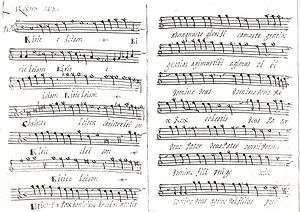Miguel de Irízar
Miguel de Irízar y Domenzain (1635–1684) was a Spanish Baroque composer.

Irízar was born in Artajona and trained as a choirboy in León and Toledo. In August 1657 he became maestro de capilla in Vitoria, then in August 1671 appointed to Segovia Cathedral where he remained for his remaining thirteen years.[1] He died at Segovia.
The correspondence of Irízar preserved in the cathedral of Segovia archives contains a total of 362 letters received during the period 1663 to 1684. There are numerous requests to Irízar to compose music for the chapels of other cathedrals, or to exchange for works by composers such as Cristóbal Galán and Carlos Patiño. Some of these compositions were part of the repertoire taken to the New World. The correspondence also includes extensive detail on performance practice.[2] The letters indicate in particular the wide and rapid circulation of villancicos between different cathedrals.[3][4][5]
Discography
- Miguel de Irízar. Mass for 6 voices. 10 Christmas pieces. Ecos y afectos. Capilla Jeronimo de Carrion, dir. Alicia Lazaro. Verso VRS2024, Spain 2004.[12]
References
- Matilde Olarte Martínez. Miguel de Irízar y Domenzain (1635-1684?): biografía, epistolario y estudio de sus lamentaciones Secretariado de Publicaciones, Universidad de Valladolid, 1996 ISBN 84-7762-610-3
- Matilde Olarte Martínez Aportaciones de la correspondencia epistolar de Miguel de Irízar sobre música y músicos españoles durante el siglo XVII Cuadernos de arte de la Universidad de Granada, ISSN 0210-962X, Nº 26, 1995 , pags. 83-96
- The New Grove dictionary of music and musicians, Volume 12 2001 p574
- James Haar European music, 1520-1640 - 2006 p. 470
- Louise K. Stein Songs of mortals, dialogues of the gods: music and theatre in seventeenth Century 1993 p300
- José López-Calo Las Misas policorales de Miguel de Irízar. Príncipe de Viana, ISSN 0032-8472, Año nº 46, Nº 174, 1985 , pags. 297-316
- Alicia Lázaro. "Ecos y Afectos". Fundación Don Juan de Borbón Colección Maestros de Capilla de la Catedral de Segovia. Segovia, 2005, ISBN 978-84-923988-3-6
- José López-Calo Los Motetes de Miguel de Irízar. Encomium musicae: essays in memory of Robert J. Snow / coord. por David Crawford, 2002, ISBN 0-945193-83-1, pp. 471-492
- José López-Calo Los villancicos policorales de Miguel de Irízar (1635-1684) 1989
- Paul R. Laird Towards a history of the Spanish villancico: 1997 p179
- Alicia Lázaro. "Ecos y Afectos". Fundación Don Juan de Borbón Colección Maestros de Capilla de la Catedral de Segovia. Segovia, 2005, ISBN 978-84-923988-3-6
- review by M.Desmet